Color Theory: Brokeback Mountain and the Complexion of Longing

Ang Lee is one of film history’s most exceptional cases of career acrobatics. The juggernaut chameleon has directed (often produced, and sometimes written) Taiwanese dramedy and Taiwanese-American romcom classics, like Eat Drink Man Woman and The Wedding Banquet (recently remade from Lee and company’s original screenplay), a timeless British period piece in Sense & Sensibility, an erotic suburban family drama in The Ice Storm, an epic Civil War western in Ride with the Devil, and all of that came before his breakout, the highly stylized, prestige martial arts picture he’s still best known for: Crouching Tiger, Hidden Dragon, which got 10 nods from the Academy and took home four Oscars in 2001.
Needless to say, Hulk – one of the only Marvel superhero movies to predate the established style and extended universe that have creatively sunk them – was not on anyone’s bingo card for Lee’s follow-up. And the quiet, queer cowboy anthem under the microscope here, Brokeback Mountain, couldn’t have seemed further from the direction he was heading after Hulk. Lee would continue his unpredictable streak with a return to Taiwan with a dark sexual thriller, Lust, Caution, one of less than 40 NC-17 films ever distributed in America and the highest grossing in film history at the worldwide box office. After an equally unexpected shift to the dry indie comedy in Taking Woodstock, he won his second Best Directing Oscar for The Life of Pi and used his veteran freedom to prove how unboxed he was with whatever the hell Billy Lynn’s Long Halftime Walk ended up being, a rare Lee blunder.
Brokeback’s gay love story knocked pop culture on its ass, ushered in a new era of queer cinema, and bust open the conversation around society’s understanding, expectation, and embrace of gay men. It was so influential – earning Lee his first Best Directing Oscar along with wins for Original Score and Adapted Screenplay, out of eight total nods – that its historically accurate, doom-and-gloom sense of ill-fated destiny would become the most trafficked gay cinema trope over the next decade. Honing in on the film’s thoughtful and nuanced use of color, we can understand why just a little better. On the heels of the 20th anniversary of Brokeback Mountain – Ang Lee’s most refined film, which still hits like a ton of bricks in 2025 – we look back at a curated set of frames to examine the way he uses color to draw out and enrich moods, tones, characters, themes, and more.
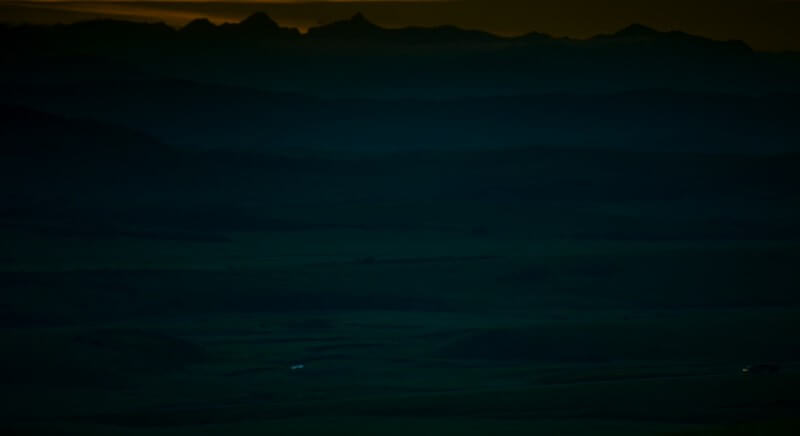
Over the windswept hush of the Signal, Wyoming mountain range that will soon wear its name in the form of the title card, the most painterly shot of Brokeback Mountain (courtesy of DP Rodrigo Prieto) fades in slowly to open the film. Much like Michael Mann did to set the natural stage for The Last of the Mohicans, Lee sets the tone of his ninth feature with breathtaking landscape footage of the consequential setting itself. But where Mann used two frames, a long tilt, and an even longer pan to stretch us across the Mohican valley, Lee points the camera unflinchingly at Brokeback just before the break of dawn in one dark and dimly beautiful image that seems to swoon and stare death in the face simultaneously.
The contemplative, vignetted frame is dense with soft, sullen, unsaturated forest greens that blend undetectably into gradients of midnight blue that give way to the range’s layered shadows, which hide and bury more of Brokeback than they reveal in this particular palette. A loud streak of burnt orange tops the scene with a faint but lusty crown of color and vitality. The heart-heavy hues of blues and greens in the frame, which bleed in slowly as the shot fades in, reflect the barely burgeoning meeting between Jack Twist and Ennis Del Mar as much as they point to the prolonged suffering to come.
After 12 seconds, a tiny truck, nearly camouflaged into the landscape, enters the frame on the bottom right side, carrying Ennis toward Brokeback and us into the story. Together, we cruise, eyes barely open, as Ennis’s always are, through the inky morning hues of the visually closeted American West depicted in haunting gray blues, blue greens, and black browns.
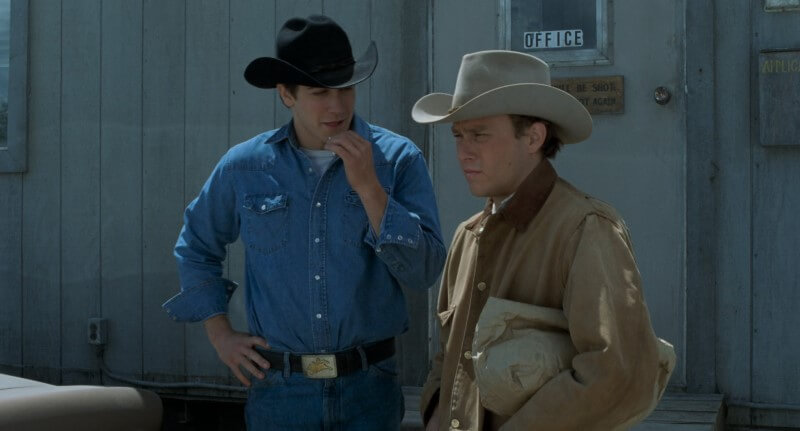
Before we see Brokeback in gaping beauty, we meet the boys (played timelessly by Heath Ledger and Jake Gyllenhaal). This frame, from their first encounter in 1963, shows them babyfaced, unworn by weather or wanton love, and finally talking (or, one of ‘em, anyways) after a drawn out, brilliantly edited four minutes in each other’s presence packed with punchy poses, brief glances, and mutual repression so strong it can’t conjure a conversation with no else around. (Thanks to editors Dylan Tichenor – who’s responsible for There Will Be Blood’s wordless working man’s thrill of an opening – and Geraldine Peroni.) The heavily contrasted colors and styles of their outfits are dead giveaways for what type of people they are and will grow to be (and how much money they’ll have).
Minutes prior, Jack Twist rolls up in a dusty-black GMC pickup truck from the 1940s. It matches his much blacker hat, his thick black belt adorned with a shiny gold and silver buckle, and his dark boots, too dusty to make out a color. His monotone, ribbon blue Canadian tuxedo might seem like a fashion statement if it weren’t for the blue collar white tee popping out at the top of his pearlsnap. Blue often represents loyalty and trust, as well as melancholy, pointing to Jack’s reliability between the two and his forthcoming depression around their growingly infrequent encounters post-marriage.
There’s a confidence in the metals of his rodeo buckle and a sharpness, a feistiness, to the black of his hat that points to the dark places he’s willing to go. In retrospect through color in costume, it’s no surprise that Jack introduces himself in the moment, does all the unabashed initial staring, eventually initiates the romance, and becomes the strung-along party. Just like it’s no surprise that Jack, in his cute, flirty, manicured presentation, is a bottom. Jack is the kind of guy that won’t accept restricted conditions, whether it’s a dour food situation or an inability to live as he is. That headstrong approach is what leads to his murder.
Ennis, on the other hand, just wants to keep his head down and make the proverbial boss happy. He hitchhiked into town. His rugged get-up is the opposite of Jack’s in color – innocent, modest, natural. He wears six shades of light brown that range from the dirty sheep skin white of his hat to the camel body of the tightly buttoned coat that covers him up so tightly you can hardly tell there’s a sky-blue button-down under there. Beneath the frame, his stonewashed shade of blue jeans connects the two. They have nothing but each other, though at this point in Brokeback Mountain they don’t know it yet.
Ennis only ever wears the colors of earth and sky, a true blue, old world American boy who will do hard manual labor living paycheck to paycheck for the rest of his life – not traveling past state lines, keeping his thoughts to himself, having the occasional violent outburst or compulsive side-of-the-road vomit forged by the fire of regret. When we see Jack’s parka on the trail later, it’s a couple wooly shades of forest green with an Ennis-colored golden brown interior that surrounds Jack’s face and chest like a lion’s mane.
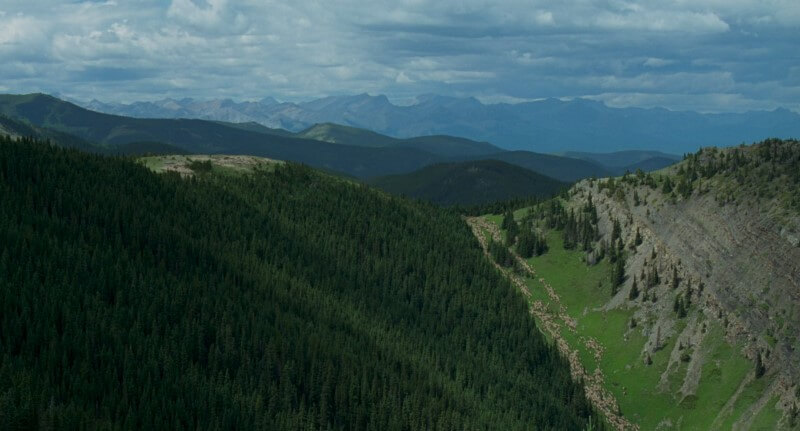
We hardly ever see the titular Brokeback Mountain in as dark and spectral a light as we do in the opening shot. On the contrary, Lee and Prieto usually depict it in overcast light or as they do here, in clear-eyed beauty. Why? Because it’s the only place where they can love each other freely, the only place that allows them to embrace the beauty of being gay. The thick hunter and palm greens of the spruces, firs, and pines are draped over the mountain like a dark velvet throw flanked by the spring green of the fresh grass. There’s an effervescence in the latter shade and a foolhardy resilience in the former, one swimming in the deep, emotional riches found in the forest. A covert smattering of almond-colored sheep lines the lawn from top to bottom – the boys buried in there somewhere on horseback – while the varicolored slate gray of the shoulder reaches out to them like veins running through the body of the range.
The infinite shades of steel, powder, and Carolina blues that adorn the sky spill onto the mountains in the distance, lending the deep range the color and texture of the clouds above them in what amounts to a celestial, soul-lifting depiction of Brokeback. The bright, clean, cool colors are stunningly natural, but together they create such a gorgeous scene that the natural, in this case, becomes the fantastical, as the wonders of Earth often do at their most unbelievable.
When relaying the awful news to Ennis over the phone at the end of the film, Lureen (Anne Hathaway) admits she doesn’t know where Brokeback is. “Knowing Jack, it was probably some pretend place, where bluebirds sing and there’s a whiskey spring,” she murmurs dismissively in reference to “Big Rock Candy Mountain,” the iconic hobo hymn that hallucinates a heaven for its disillusioned subjects. In one sense, she’s right – Brokeback is their escape. But in another sense, she shirks the reality, the legitimacy of what they had in one dagger of a targeted assumption that cuts through the eviscerated Ennis as he receives the worst news he could possibly imagine.

There’s no wildflower yellow or Ferrari red to be found in the nirvanic turquoise-tinted nature sequences that serenely depict Jack and Ennis’s first summer together shepherding sheep, still sizzling with some of cinema’s most tangible sexual tension, no less hot today than it was when it came out. The lush emerald grass and the shimmering aquamarine river are hard to look away from. The dust-blown country creams of the mountainside, steep with desire, can be found in the boomerang of sheep through the frame, whose various hues throughout the film – from a glowing off-white to beige to gold to all kinds of dirty neutrals to twilight blues in the night – always accent the composition, both with color and a sense of practicality, given how chimerical the Brokeback scene is in color. It’s so magnetizing, it makes one wonder if perhaps they should be shepherding Wyoming sheep for a living.
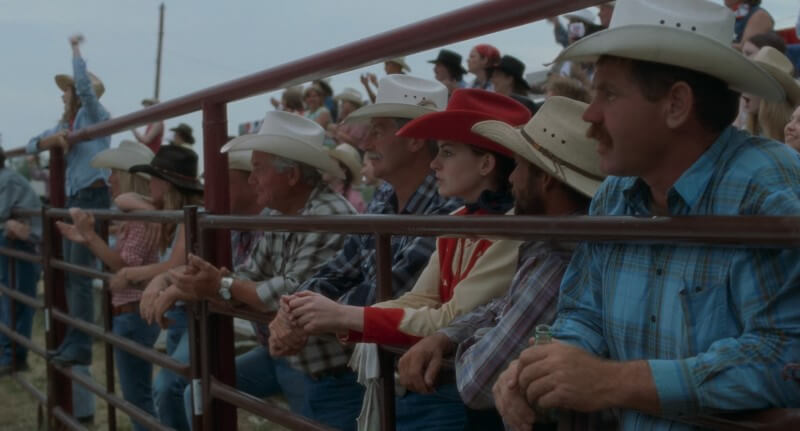
When it comes to imposed and unnatural colors in Brokeback Mountain, Lee looks to the women and children. Take, for instance, the depiction of Lureen, the prettiest little gal in Childress, Texas, upon first meeting Jack, in a row of men at the rodeo. The daughter of a traditional Texan father – complete with beer gut, pigskin-first principles, and an insensitive arrogance toward anything that can be interpreted as feminine – Lureen is looking for a strong, rodeoin’ man. It’s impossible to miss her candy apple red cowgirl hat and matching western wear in the sea of muted, natural earth tones worn by the men surrounding her.
Visually, it’s a blatant warning, a fire alarm sounding off outside, flagging the danger that will follow if Jack plays straight. It’s no coincidence that the gate is maroon, that the woman above her wears a bright red bandana, or that the cluster of three women at the left end of the gate are all wearing red. Similar to Lureen in red, Alma (Michelle Williams) is often depicted in shades of pink, the neighboring colors acting as stand-ins for the normativity, heterosexuality, and domesticity they bring into Jack and Ennis’s lives. The dainty pastels and sexy reds of the women pit themselves against the plain, natural (and oft-no-less-striking) colors of Brokeback and men.
When we do see red on or near the men in the country, it’s muted, like the paint job of a truck gone garnet, and/or acting as a cover, like the rural red wool button down Jack dawns for their first meeting in four years. In their final scene together, Jack wears a red vest over the classic denim blue colors of Ennis’s clothes underneath as a depiction of who he really is, or what he really wants, up against who he presents as and what he has.
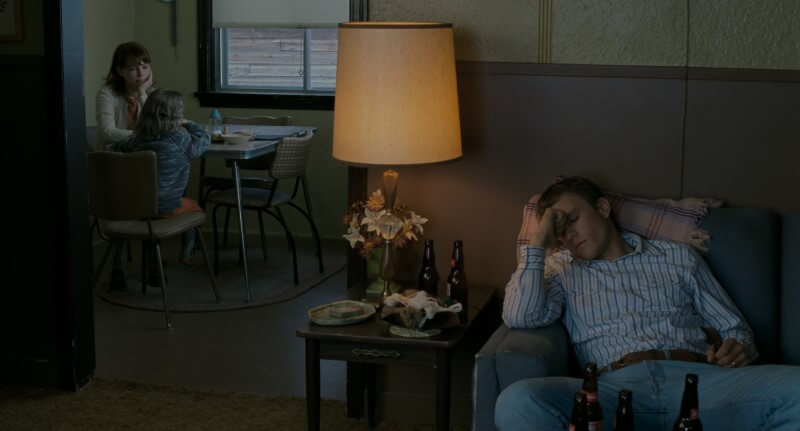
Cold shale tones pierce the window behind the breakfast table in the back, dressing the room (and Ennis’s marriage) up in deadening neutrals that blend together from the floor, to the rug, to the table, to the chairs, to the wall, to Alma’s outfit. In comparison, the warm, honey-orange hope of the lampshade (and flowers) stand out in the foreground and beat down on the nervous-drunk Ennis, who’s leaning into the light as hard as he can. Orange often represents excitement and energy, as it does here, a sore thumb in the frame’s palette on behalf of the giddy Ennis, who, despite his visage, is wide awake, ready to jump out of his chair at the first sound of tires crunching onto the gravel driveway.
The repugnant 60s-era walls of their humble duplex are split between a milky puke green and skidmark brown. They’re dull in color, even in comparison to something as mundane as Ennis’s trademark sky blue outfit. But, more importantly, they’re nauseating, a reflection of the mood when we’re inside, witnessing the family’s miserable life together. Even the cesspool color of the living room rug gives off a foul odor. The seismically contrasted art department touch of the pastel blanket draped over the couch behind Ennis is the flowering, butterfly feeling inside him, dreamy in lilac, lavender, and peach tones that seem to exist outside of the home’s orbit and depict the schoolgirl behavior he’s about to exhibit.

Then, there’s the other side of Ennis. In the immediate aftermath of a sudden ass-kicking – barely seen in the cowering goon in the bottom left hand corner and front and center in Ennis’s clenched fist and lunging posture – a ruby red haze of smoke of inner anger rises from the gloomy Oxford blue of the plumes below as fireworks explode in the night sky behind him in a fashion so spectacular it would make Brian De Palma proud. The energy and color from the fireworks are like sparks of emotion going off in Ennis that he can’t control, outbursts that stir up violence, keep his loved ones at a distance, and push his self-censored feelings deeper down into the abyss he tosses them into.
Where the colors of anger and sadness meet in the middle, we find the same dour shade of bubblegum pink Alma can be seen wearing in the bottom right hand corner of the frame. Though it’s not her fault, she is at the center of the torturous emotional complex Ennis tries so hard to avoid in himself, t-boned in the intersection of his self-loathing and mournful longing. It’s worth noting, too, that Ennis is wearing a Jack-esque denim-on-denim look when he’s lashing out.
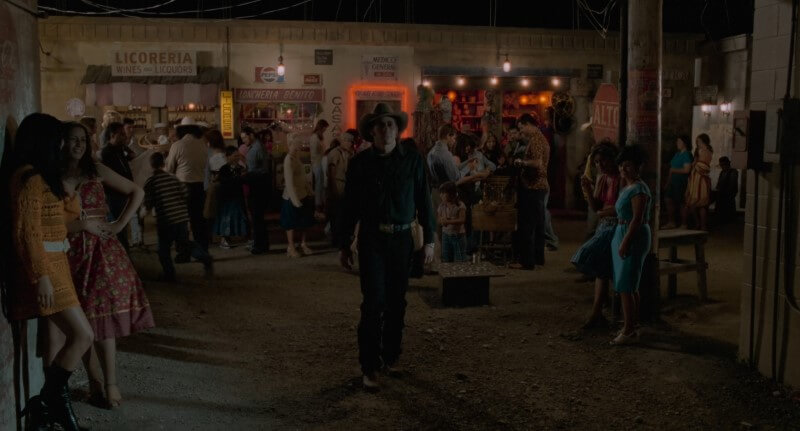
Similarly, Jack, in his silent rage, is seen wearing an Ennis-colored hat in Mexico, as he is when they see each other after their first long break. Jack’s dark side is much calmer than that of Ennis, more susceptible to self-destruction than the destruction of others, mental and emotional lashing out where Ennis’s is physical. The hazard-tinged neon red of the doorway around his head – blended with the desolate desert-dust colors of the seedy nightlife scene and the unnaturally electric reds and yellows scattered throughout the frame – is practically screaming at him to stop. In fact, there’s a brick-colored stop sign to his right that says as much, in all caps (“ALTO”).
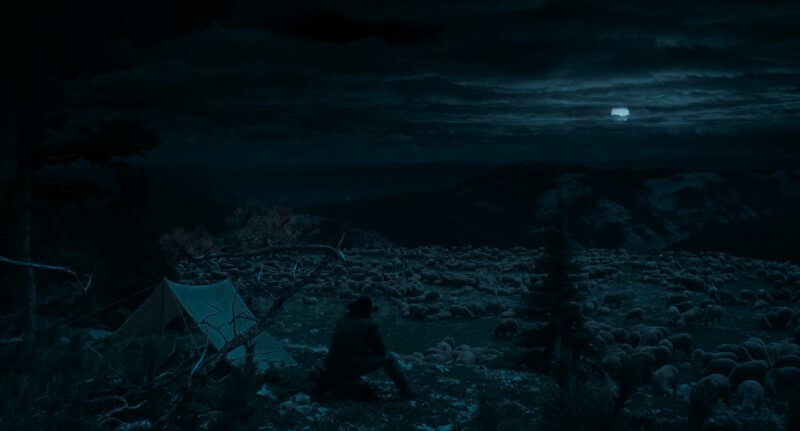
The other version of Brokeback Mountain we typically get is a somber one, dreary with overcast skies and the recurring theme of a coming storm that will eventually arrive in plot instead of weather. Even on cloudless days, the storm is depicted in the swirly, silvery-blue puffs of smoke billowing from their cigarettes. This shot, however, takes the concept to the nth degree. Unlike the other gloomy Brokeback shots, which have balanced palettes, this monotone twilight blue composition captures loneliness in cinematic incarnate. Alone at the pup tent on top of the mountain, during the short stretch when they’re unexplored and still sleeping apart, Jack sits in icy isolation overlooking the herd of sheep that blend in with the rocks, darkness overflowing from the frame.
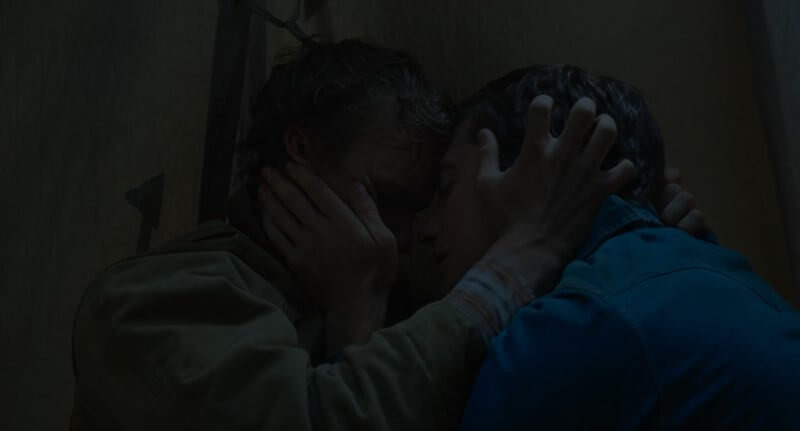
The pale, hardly moonlit colors of their first fuck play with a similar mood through the hiddenness and shame that defines the aggressive encounter. After some time together, Jack makes the move, pulling Ennis’s hand down his pants in the middle of the night, only to find a fight. As the two wrestle through the ultimately irresistible tension, the closed tent shuts out almost all light, except for that of the moon peeking through with a melancholic, dejected spirit. No words will be shared the morning after the rocky, brutal experience, the concept of aftercare – or some mutual respect at least – gralloched by Ennis’s overwhelming guilt, as the colors above foretell.
Their romance is almost never portrayed in the light of day, but the two times it is, their love represents a crossing of societal boundaries that carries severe consequences. In the first, at the end of their initial summer on Brokeback, bossman Joe (Randy Quaid) sees them kiss and refuses to hire Jack back the following summer, revealing his homophobia. In the second, Alma accidentally catches the two in a face-smashing makeout session after four years apart with no word, only to have the soul sucked out of her in real time.
When we see Jack and Ennis together during the day through the rest of the film, they’re arguing or weathering disappointments or riding horses in tranquil silence. We can glean that they’re comfortable enough out there to love each other unabashedly in the open only because no one is around. But it says a lot that Lee never depicts gay love in broad daylight without a sense of trouble or tragedy in the air.

The passionate, fiery orange shades of their second hookup – still shrouded in darkness, in the secret of the tent where no one can judge them – are like a sauna compared to the cold combativeness of their first. The tent door behind them is wide open. A fire burns bright in the background, creating the opposite mood of the glacial, closed-curtain encounter that kicked things off. The balmy mood embedded in the color is kindhearted and defanged, ripe for romance that can take its time and allow one another to appreciate the moment. Here, Ennis is sweet, tender, and receptive, the cozy-warm palette like a candle that’s melted him into Jack’s arms without a fight … finally. If only it could’ve stayed that way. As they say, “If you can’t fix it, Jack, you gotta stand it.”
Luke Hicks is a New York City filmmaker, film journalist, and musician by way of Austin, TX. He earned his Master’s studying film philosophy, theology, and ethics at Duke University and is the founder of the Brooklyn-based Art Mob Productions.